Hikers in the Pacific Northwest enjoy a wide variety of discoveries on their walks, including mushrooms, unexpected trees, and edible and inedible berries that the average person rarely sees in a grocery store. One of the treasures of the region is the state flower of Oregon, the Oregon Grape. The fruit on this evergreen shrub are actually very tart flavored berries, but they look enough like grapes that the name stuck.
What Is Known About The Safety Of Eating Oregon Grapes
Yes, there are many personal reports of people safely eating Oregon Grapes. Most people consider these berries to be safe to eat. As they are not true grapes, they don’t taste anything like them. The edible berries are very tart and packed full of Vitamin C.
A notable exception is during pregnancy. The Oregon Grape berries contain berberine. Any plant that has berberine may cause issues during pregnancy. While only healthcare providers can really give you individual advice on safety during pregnancy, it’s best to be on the safer side and consider Oregon Grapes to be inedible during pregnancy.
It’s important to note that there is limited scientific evidence surrounding Oregon’s state flower. While locals in Oregon, Washington state, and British Columbia have reported a fair amount of knowledge online, there haven’t been scientific studies done and these berries aren’t being tested by the FDA.

How People Eat Oregon Grape
The blue berries, which are often more of a dark purple, are very tart and have large seeds inside. In the past the indigenous peoples mixed them with sweeter berries like salal and made pemmican cakes.
While they can be eaten as fresh berries, not many people enjoy them that way. Instead, the berries are often used to make Oregon Grape jelly alone or mixed with salal berries. When cooked down the Oregon Grape jam is often compared to blackcurrant.
The yellow flowers are also considered edible. Some people bring the flowers home to make a drink, like a lemonade or tea.
Where Will Hikers Find Oregon Grape Plant?
Once established, the evergreen plant is very hardy. Oregon Grape can be found along the west coast of North America from Northern California up through British Columbia. It has been spotted in the shrublands, thick forests, and rocky woods. It can be happy growing in full shade, partial shade, and full sun. You may end up seeing Oregon Grape in unexpected places, since it’s happy in so many environments on the west coast.
What Else We Know About The Oregon Grape
The Oregon Grape is also known by the common names tall Oregon Grape, Oregon hollygrape, Oregon Grape holly, and the species names berberis aquifolium and mahonia aquifolium (often abbreviated to m. aquifolium). The evergreen shrub is found in the forests of Western North America.
The flower of the Oregon grape forms in the early spring and produces fruit in the early summer.
While it’s a very useful plant, it’s also an ornamental plant. Its uses are found mostly in its rich inner bark. Its beauty is found in its yellow flowers when in season, but also in its evergreen holly-like leaves. The spiny leaves have made it popular in the winter months.
Historically, Native people of the area found the Oregon Grape to be a very useful plant. Beyond the edible Oregon Grape berries, there are also the beautiful yellow flowers and its more useful root.
One unexpected way that the Oregon Grape root proved useful was as a yellow dye. It was found that when boiled down, the root creates a brilliant yellow color that was used to dye baskets and clothing.
Green dye and dark blue-purple dyes can be made from the berries depending on the pH of the water that is used to make the dye.
The Oregon Grape also became a medicinal plant. While its berries are edible and enjoyable, especially when made less tart in an Oregon Grape jam, it’s again the root where the plant was found to be most useful.
Is Oregon Grape A Medicinal Plant?
As mentioned above, Oregon Grape contains the chemical berberine, which may be harmful to pregnant people. Others have found specific medicinal uses for the plant for exactly this chemical. Specifically, the root, bark, and stem are valued for their medicinal properties.
Many people use Oregon Grape to help treat gastroesophageal reflux disease (also known as GERD), stomach ulcers, and other stomach issues. When used for the stomach, the root and stem are used to make a very bitter tonic that is then ingested.
Again, it’s important to note that while there is a lot of information available online and in books about people safely ingesting Oregon Grape as a bitter tonic, there is not enough scientific evidence supporting this to say that this is always an advisable option. It’s always best to consult a healthcare provider.
The Oregon Grape is also valued as a medicinal plant for skin conditions like psoriasis and atopic dermatitis (eczema). It has also been used topically for bacterial infections and fungal infections. The Oregon Grape root is reported to have disinfectant properties. Those with psoriasis have reported that it may be slowing the overproduction of skin cells, a common issue with the disease.
When applied to the skin, reported side effects include burning, irritation, and itching. Some people have reported allergic reactions to Oregon Grape when applied to the skin.
The Oregon Grape Is Both A Useful And Beautiful Plant
Oregon’s state flower is a beautiful plant with blue berries, yellow flowers, and holly-like spiny leaves. The plant grows in diverse areas around the Pacific Northwest and is a popular find with hikers because of its beauty and its usefulness as an edible and medicinal evergreen plant. As time goes on, outdoor enthusiasts are continuing to find more uses for the berries, flowers, and roots harvested from the tall Oregon Grape.
Recent Posts
The only venomous snakes in Washington State are Northern Pacific Rattlesnakes. The Northern Pacific Rattlesnake (Crotalus oreganus oreganus) is a sub-species of the Western Rattlesnake. Anyone...
Skunks are not classified as true hibernators. But they go into a state of torpor when the weather gets cold. Skunks are light sleep hibernators, along with opossums, bears, and raccoons. ...

